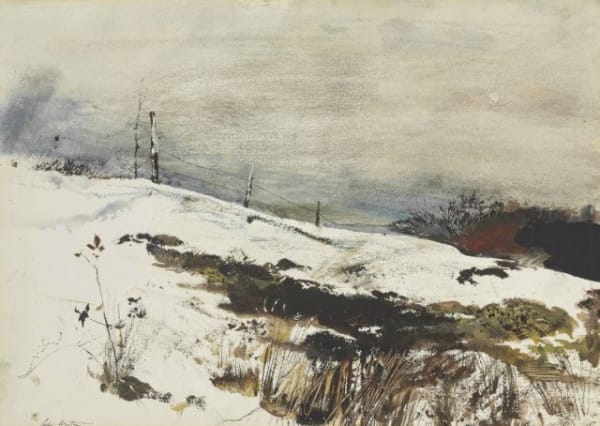Andrew Wyeth would have celebrated his 100th birthday last July.
In the early 1940s, Andrew Wyeth was viewed as a radical, surrealist painter. When abstract expressionism took hold, Wyeth was attacked by critics for not changing his style. Although the critics were unkind, the public was not and Wyeth is still one of the most beloved American artists.
Wyeth’s most famous painting, Christina’s World, is displayed, unceremoniously, next to one of the escalators at the Museum of Modern Art. Christina’s World draws the largest crowds and is probably the most famous painting in the museum. Wyeth’s son, Jamie, was told by a MoMA security guard that the questions he’s asked most often are, “Where’s the men’s room?’ and ‘Where is Christina’s World?”
Andrew Wyeth: Snow Hill
One of the people who understands the criticism of Wyeth’s work, and Wyeth himself, is American realist painter, Bo Bartlett.
Bartlett moved from his home town of Colombus, Georgia to Pennsylvania in the mid-1970s, in the hope of studying privately with Wyeth. Wyeth told Bartlett he didn’t accept private students, so Bartlett enrolled in the Pennsylvania Academy of Fine Arts (PAFA).
“I had been taught at PAFA to stay away from “illustrators” and “draftsmen” like Wyeth.” Bartlett said, “We were taught that such artists weren’t “painterly” enough and that their “handiwork” was just “skill” and “craft,” words shunned at the time as not “Modern” enough to be taken seriously by the Art World.”
In 1991, Bartlett had his first big show, and Wyeth’s wife, Betsy, saw the catalogue. She invited Bartlett to help make a film about Wyeth and, for the next four years, Bartlett spent every day with the Wyeths.
“Slowly, the scales were scraped from my eyes and I saw clearly what I’d once known,” Bartlett wrote, “that the best paintings of Andrew Wyeth were indeed masterpieces, and each piece was a unique representation of his experience. He painted his own backyard, literally, in Maine and in Pennsylvania. He didn’t care if it was “abstract” or “realistic,” he didn’t make such useless distinctions. He didn’t come up with an idea and illustrate it. He would walk out of his house each morning and with eyes wide open he would experience the world, like a zen master, he would just look and be.”
The documentary SnowHill was released in 1995. For Bartlett, the experience produced more than just a documentary film about Wyeth. The Wyeth’s were supportive of his work, bought his paintings and became life-long friends.
Andrew Wyeth at Surovek Gallery
Please contact us for more information about Over the Hill, Maine Gaff or any of the other fine work available in our gallery.
References:
Bo Bartlett. Remembering My Friend Andrew Wyeth on His 100th Birthday. HYPERALLERGIC. July 12, 2017.


